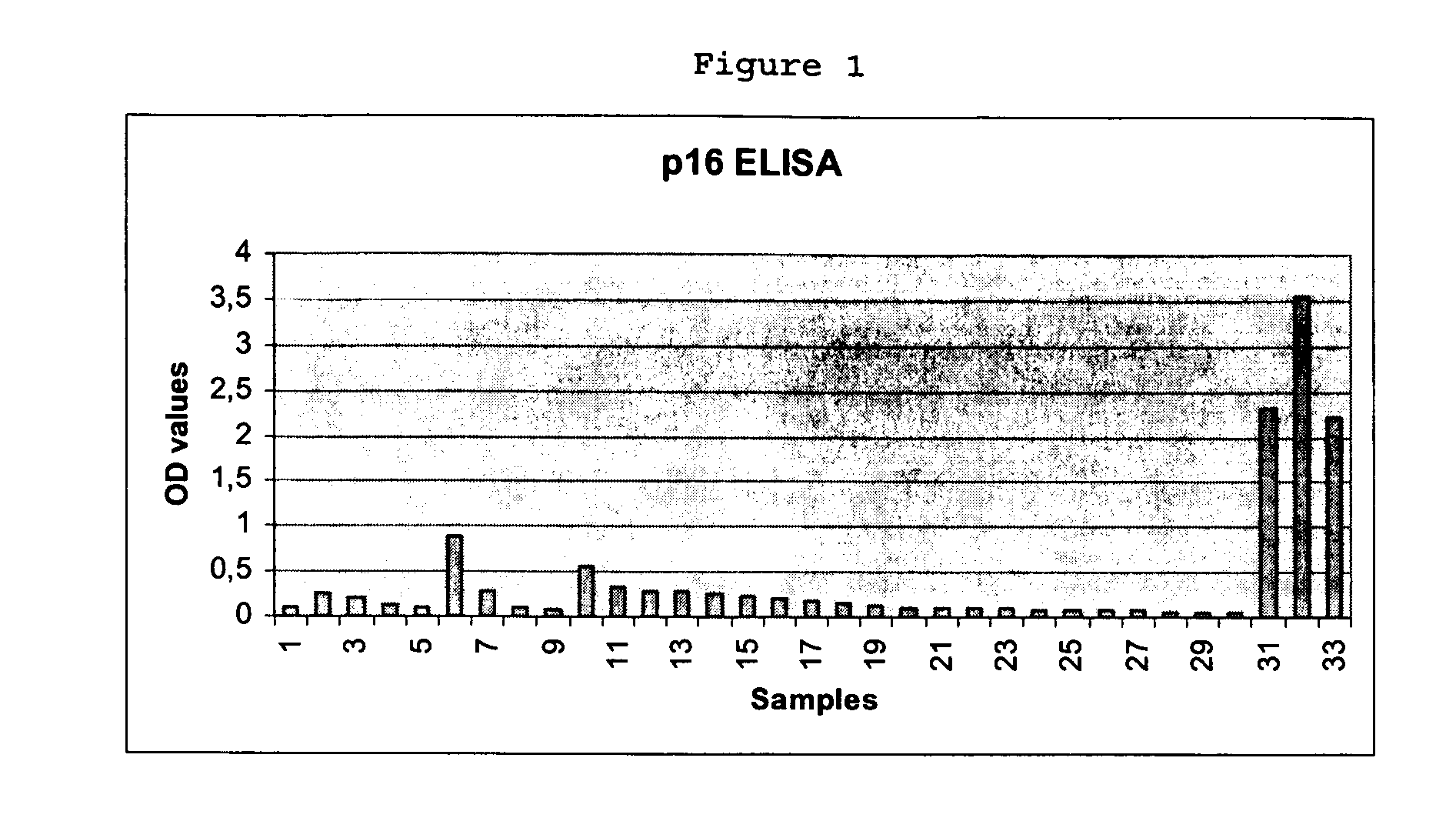Method for detecting neoplastic disorders in a solubilized body sample
a solubilized body and neoplastic technology, applied in the field of solubilized body sample neoplastic disorders detection, can solve the problems of high inter- and intra-observer variance of experienced examiners, unsatisfactory false positive and false negative results of screening tests, and the inability to overcome the problem of preservation and preparation of samples by simply adding molecular markers, etc., to achieve effective and reliable kits and improve the morphological evaluation of cytology specimens
- Summary
- Abstract
- Description
- Claims
- Application Information
AI Technical Summary
Benefits of technology
Problems solved by technology
Method used
Image
Examples
example 1
Detection of Cervical Intraepithelial Neoplasia in an ELISA Test Format
[0161] 33 cervical swabs provided in a lysis medium were subjected to ELISA based detection of overexpression of cyclin-dependent kinase inhibitor p16INK4a in solutions prepared from the cells contained in the swabs. The ELISA testing was performed as follows:
[0162] Cervical swab brushes were given into 15 ml vessels, containing 2 ml of mtm lysis medium (2% Triton X-100, 0.4% SDS, 0.6 mM PMSF in PBS). Cervical cells present in the brush were lysed for at least 20 h. The lysates of the cervical swab samples were then transferred in 2 ml tubes and were centrifuged at 4° C. (15 min at 28.000×g (16.600 rpm Highspeed Centrifuge JEC Multi RF)); -Supernatant was transferred to a fresh tube. The Supernatant may be stored at −20° C.
(B) Performing the ELISA
[0163] Coating of ELISA-plates
[0164] Stock-solution of p16INK4a specific antibody clone mtm E6H4 was diluted in PBS to give ready-to-use coating so...
example 2
Detection of Cervical Intraepithelial Neoplasia in an Lateral Flow Test Format
[0194] Nine cervical swabs provided in PreservCyt (Cytyc Corporation, Boxborough, Mass.) solution have been subjected to conventional PAP testing and simultaneously to lateral flow based detection of overexpression of cyclin-dependent kinase inhibitor p16INK4a in solutions prepared from the cell suspensions obtained from the swabs. The lateral flow testing was performed as follows:
[0196] 10 ml of the cell suspensions from the individual cervical swab samples provided as PreservCyt™ fixed materials were transferred to a 15 ml reaction vessel. The samples were centrifuged 15 min at ambient temperature at 1500×g (3000 rpm, Heraeus Varifuge, rotor 8074); supernatant was discarded, and remaining methanol allowed to evaporate (15 min at ambient temperature); the pellet was solubilized in 500 μl Lysisbuffer and transferred to a 1.5 ml reaction vessel. The solution was centrifuged at 4° C. ...
example 3
Detection of p16INK4a and p14ARF Transcripts by RT-PCR,
[0208] Cervical samples from 50 individuals were used for this analysis. For each individual two samples were obtained, one in Universal Collection Medium and one in PreservCyt™ solution. Both samples were obtained during the same examination session. For each of the individuals a diagnosis based on analysis of a cervical thin layer specimen prepared out of the PreservCyt™ solution was available. 20 of the samples included in the present study were chosen to be diagnosed as NILM, 20 samples were chosen to be LSIL and 10 samples were chosen to be HSIL. From all samples the level of transcripts of p16INK4a and of p14ARF have been determined on an mRNA level by RT-PCR according to the following protocol:
[0209] For performance of the analysis the cells were pelleted from the UCM and PreservCyt™ solutions by centrifugation. The pellets obtained were directly subjected to the RNA preparation procedure.
[0210] The pellet was diluted ...
PUM
| Property | Measurement | Unit |
|---|---|---|
| Electroluminescence | aaaaa | aaaaa |
| Level | aaaaa | aaaaa |
| Chemiluminescence | aaaaa | aaaaa |
Abstract
Description
Claims
Application Information
 Login to View More
Login to View More - R&D
- Intellectual Property
- Life Sciences
- Materials
- Tech Scout
- Unparalleled Data Quality
- Higher Quality Content
- 60% Fewer Hallucinations
Browse by: Latest US Patents, China's latest patents, Technical Efficacy Thesaurus, Application Domain, Technology Topic, Popular Technical Reports.
© 2025 PatSnap. All rights reserved.Legal|Privacy policy|Modern Slavery Act Transparency Statement|Sitemap|About US| Contact US: help@patsnap.com

